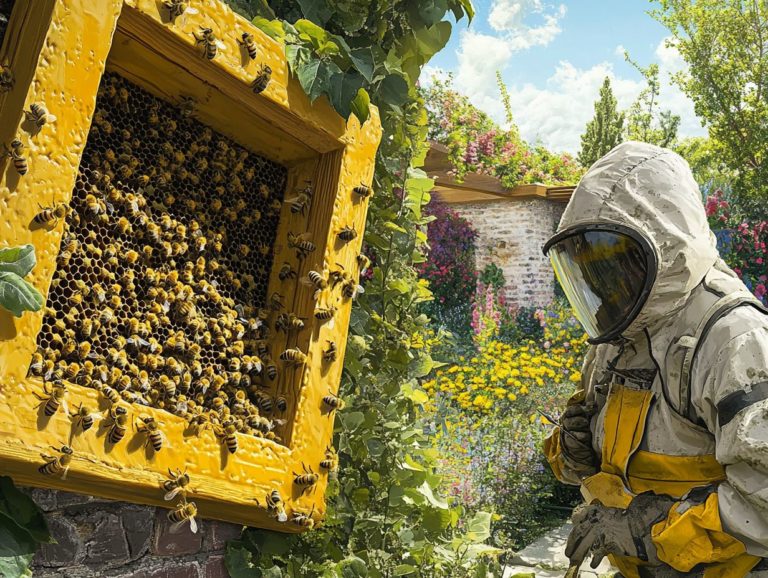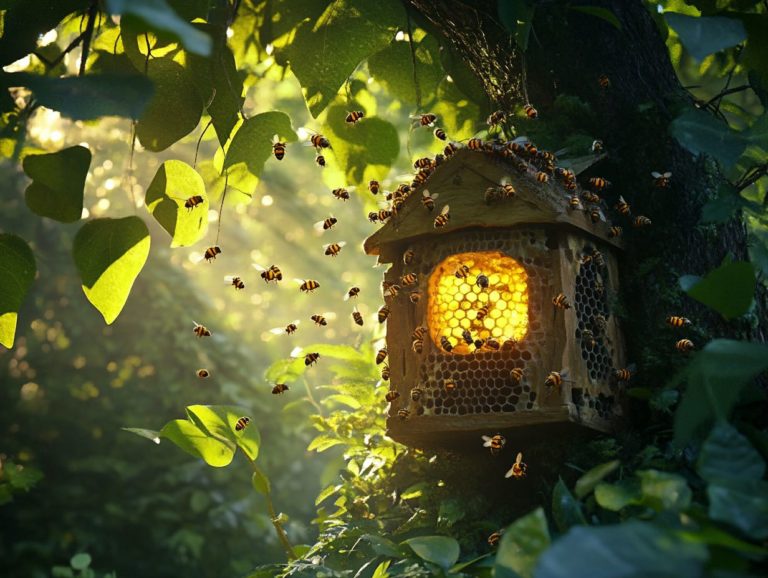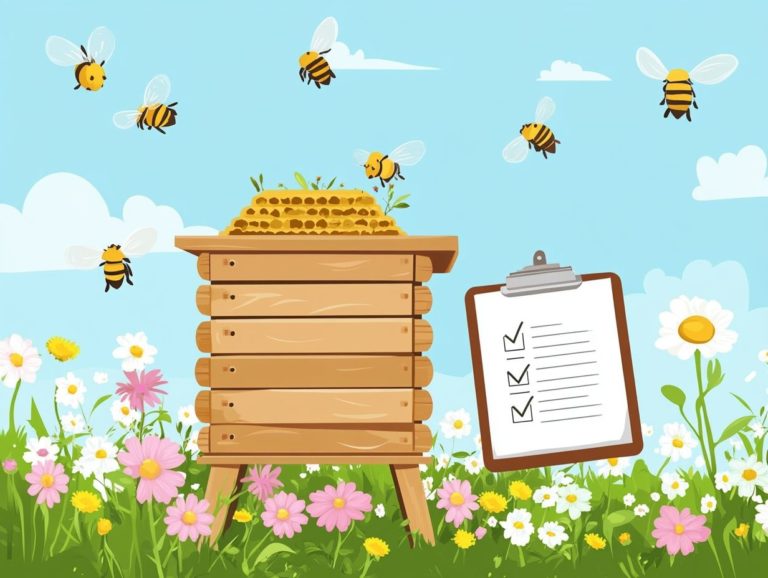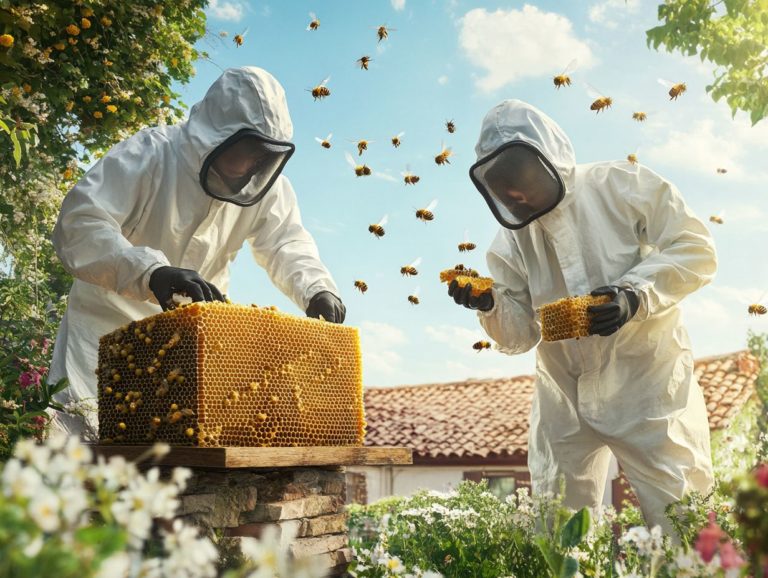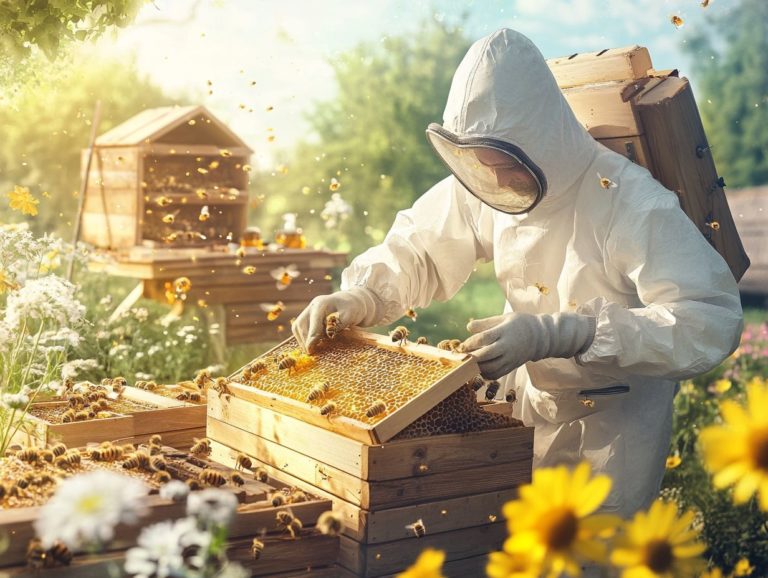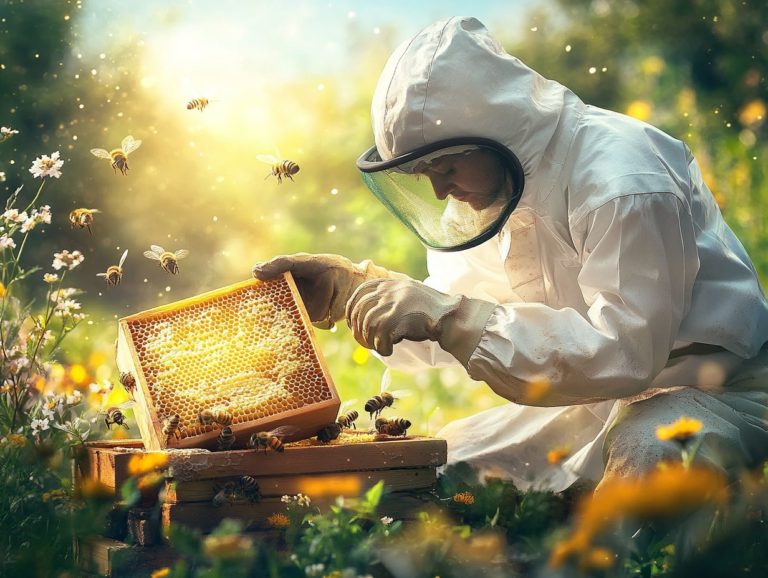Understanding Bee Communication in Hives
Communication is essential for the survival and efficiency of bee colonies. It plays a crucial role in shaping their social structure and maintaining harmony within the hive. The study of bee communication has been significantly advanced by researchers like Karl von Frisch and Dr. J rgen Tautz.
This article invites you to explore the captivating realm of bee communication! You ll discover fascinating methods bees use to communicate, from the chemical language of pheromones that convey vital information to the intricate dance moves that bees perform. Honeybees utilize these dance moves, often in a figure-eight pattern, to direct other bees to nectar-rich flowers.
You ll also learn about the lesser-known methods of touch, vibration, and sound that bees use in their interactions. These communication mechanisms are vital for hive defense and coordination among worker bees.
By delving into these unique communication strategies, you will gain valuable insights that can benefit beekeepers and enhance your understanding of communication as a whole. The complex communication methods employed by honeybees are a testament to their collective intelligence and sophisticated social behavior.
Contents
- Key Takeaways:
- The Role of Pheromones in Bee Communication
- The Dance Language of Bees
- Other Forms of Bee Communication
- The Importance of Understanding Bee Communication
- Frequently Asked Questions
- What is bee communication (Robobee)?
- How do bees communicate?
- What is the purpose of bee communication in hives?
- Can bees, including the European honeybee, communicate with other species?
- What is the role of pheromones in bee communication (Apis mellifera)?
- How do bees, as studied by Karl von Frisch, use dances to communicate?
Key Takeaways:
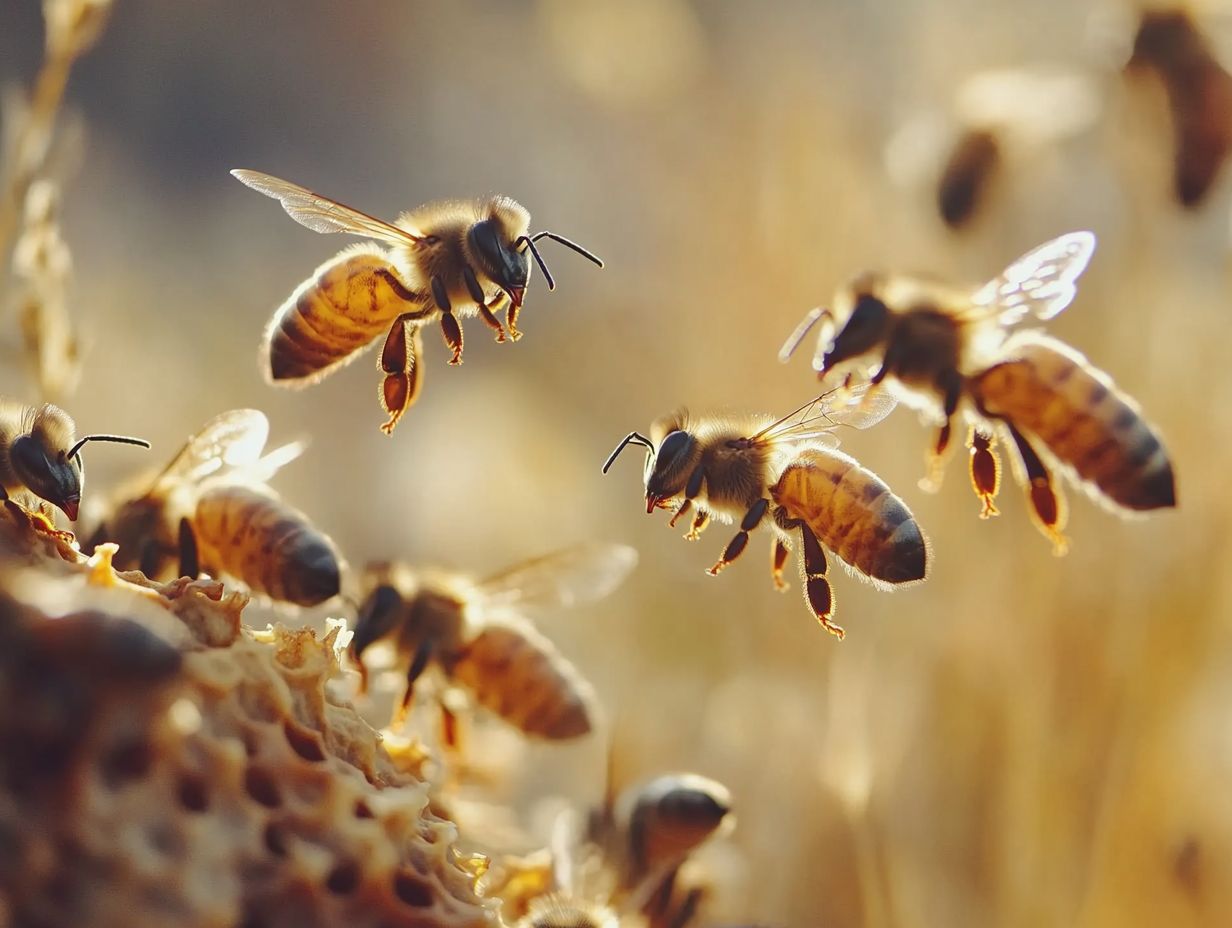
- Bee hives rely on communication for survival and harmony, with individual bees playing specific roles such as scout bees and foraging bees.
- Pheromones are key to bee communication, helping maintain hive unity and organization. The queen releases a specific chemical that ensures reproductive control among worker bees.
- Bees use dance, touch, vibration, and sound to communicate vital information within the hive. These vibrational signals are crucial for effective communication among hive mates.
What is the Importance of Communication in Bee Hives?
Communication is essential for maintaining the structure and efficiency of bee hives. Honey bees employ intricate methods to share information about food sources, threats, and hive activities. This includes the use of scent receptors to detect pheromone signals and guide worker communication.
Among these methods, communication through chemicals serves as a pivotal element. Bees release pheromones, like the chemical released by the queen bee, which signals to worker bees the presence of a healthy queen and regulates their reproductive urges. This pheromone fosters a sense of unity within the hive and inspires workers to attend to the colony’s needs.
Tactile signals, such as grooming and body movements, reinforce social bonds and convey immediate messages about the state of the hive. When bees engage in a waggle dance, they communicate both the direction and distance of food sources. These dances are crucial for foraging bees, underscoring the significance of these sophisticated communication techniques in ensuring the overall health and productivity of the bee colony.
The Role of Pheromones in Bee Communication
Pheromones are subtle chemical signals crucial to bee communication. They shape a range of behavioral responses in honey bees and enhance their social dynamics within the hive. These pheromonal cues play a vital role in maintaining the unity of the colony and keeping worker bees informed about the hive s condition. Honeybees use their antennae to detect these signals.
Alarm pheromones are particularly significant as they alert worker bees to potential threats and rally the colony for defense. This intricate interplay of pheromones underscores their fundamental role in the social fabric and survival of bee colonies, ensuring that bees can relay essential information to their hive mates effectively. This communication mechanism is crucial for hive defense and overall colony cohesion.
What Are Pheromones and How Do Bees Use Them?
Pheromones are special chemical substances that bees secrete to convey important information about their social behavior. This includes everything from foraging and reproduction to alarm signaling. Honey bees use these pheromones to create a complex communication network, alerting their hivemates about nectar-rich flowers or potential dangers. Bees have an excellent scent memory, which helps them track these signals efficiently.
For example, the queen’s mandibular pheromone is very important for maintaining colony unity and preventing worker bee reproduction. In contrast, alarm pheromones trigger a quick defensive response from worker bees to protect the hive. Researchers at Cornell University have studied these fascinating mechanisms in-depth. Through these signals, bees showcase smart communication strategies that form the backbone of their social structure.
Bees detect these chemical signals using special scent receptors on their antennae, allowing them to perceive even the tiniest concentrations of pheromones in their environment. The classification of pheromones goes beyond just alarm or reproductive cues. For example, trail pheromones guide fellow bees to food sources, while brood pheromones encourage nurturing behaviors towards the young. These detailed signals are crucial for keeping the hive running smoothly.
The intricate forms of communication have a significant impact on hive dynamics, promoting cooperation and a division of labor. This ultimately enhances the colony’s survival. By interpreting these chemical messages effectively, each bee plays a crucial role in maintaining a well-organized society, ensuring that the colony can respond swiftly to environmental changes and protect their collective existence. This is vital for tasks such as nectar processing and adapting to temperature changes within the hive.
How Do Pheromones Help in Maintaining Hive Harmony?
Pheromones are essential for maintaining hive harmony. They serve as vital communication tools that facilitate interaction among the queen bee, worker bees, and the entire colony. The queen’s mandibular pheromone signals her presence and health. This chemical helps suppress the reproductive urges of worker bees, keeping the colony focused on important tasks like nectar processing and defending the hive. This pheromonal communication fosters a united social structure, allowing the bees to coordinate effectively and respond to environmental changes.
The balance maintained by these pheromonal signals is crucial for adapting to various situations, such as fluctuations in food availability or threats from predators. When alarm pheromones are released, worker bees respond quickly, mobilizing to defend the hive or relocate resources. This showcases a remarkable communal instinct driven by chemical messaging. Such adaptive behavior is critical for the survival and longevity of the bee colony.
This adaptability signifies not just a direct response but also a deeper understanding among the bees regarding their environment. It influences behaviors like foraging, brood care, and overall hive maintenance. This seamless communication, including the use of vibrational signals, empowers the colony to thrive, ensuring not only survival but also the longevity of the hive itself.
The Dance Language of Bees
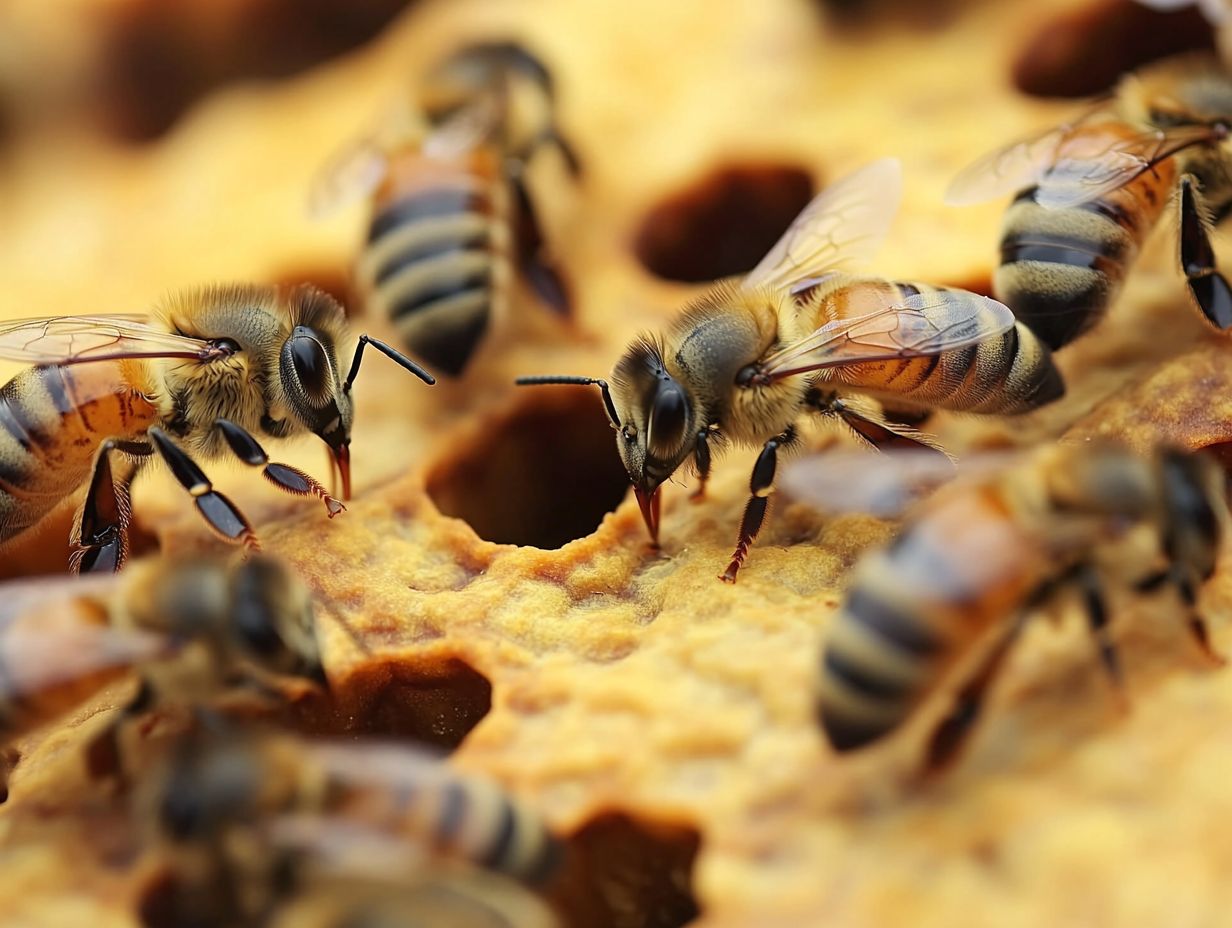
Watch as the bees perform a dazzling figure-eight dance! This incredible dance language, especially the waggle dance, enables foraging bees to relay the location of nectar sources to their fellow hive members.
This intricate dance unfolds in a captivating figure-eight pattern, where the duration and angle of the waggle run convey both the distance and direction to the food source. The concept of bees dancing was first studied by Karl von Frisch, who decoded the meaning behind these movements.
By employing this complex dance language, honey bees effectively share vital information, enriching the collective intelligence of the colony. This not only streamlines nectar collection but also nurtures a spirit of cooperation among worker bees, ensuring a consistent supply of resources essential for the hive’s survival and the art of honey production.
In conclusion, understanding how bees communicate is not only fascinating but crucial for appreciating their role in our ecosystem. Learn more about these remarkable creatures and consider supporting their habitats!
What is the Purpose of the Bee Dance?
The primary purpose of the bee dance, especially the waggle dance, is to communicate the location and quality of nectar sources to foraging bees. This optimizes resource acquisition for the hive and ensures the colony can gather nectar effectively. Such communication is important for honey production.
This sophisticated form of communication conveys critical information about distance, direction, and the richness of the nectar source. By utilizing movements and vibrations during the dance, the bee enhances foraging efficiency, ultimately contributing to honey production and the sustainability of the hive.
During the waggle dance, the bee performs a series of specific movements. These include a waggle run, which is a straight movement used to communicate distance, followed by turns that create a figure-eight pattern. The angle at which the bee waggles its body in relation to the vertical axis of the hive indicates the direction of the nectar. The duration of the waggle run correlates with the distance to the food source. For instance, a longer waggle signals a farther distance, guiding fellow foragers to travel efficiently.
When other bees observe this dance, they interpret the movements as crucial navigational cues. This enables them to adjust their foraging strategies to maximize the hive s productivity. This remarkable system of communication enhances efficiency and fosters a sense of collaboration within the colony, ensuring all members work toward a common goal. Such advanced worker communication is essential for the hive’s success!
How Do Bees Use the Dance to Communicate?
Bees communicate in a fascinating way, particularly through the dance known as the waggle dance. This intricate method allows them to convey precise details about the location and quality of nectar sources to their fellow worker bees.
As a foraging bee performs its dance, it executes a series of movements that include a waggle run and a figure-eight pattern. This choreography effectively communicates the distance and direction of the nectar source in relation to the sun’s position.
The dance not only imparts critical information but also enhances the collective intelligence of the bee colony. This facilitates efficient foraging and resource allocation. Some studies on robotic bees, like Robobee, aim to mimic these complex communication strategies.
As you observe the waggle dance, you’ll notice how bees decode specific details. For instance, the angle of the waggle run indicates direction relative to the sun. They also pay close attention to the duration of the waggle phase; a longer waggle indicates a nectar source that is farther away. Environmental cues like landmarks and scents further assist them in pinpointing the exact location of flower patches. This unique relationship between bees and flowers benefits both parties.
This effective communication boosts overall foraging efficiency, minimizing the time spent searching for food while maximizing nectar collection. This ultimately supports the hive s productivity and survival. Studies from renowned institutions like Cornell University have provided significant insights into these processes.
These synchronized actions reveal the remarkable complexity of decision-making processes within the colony. This showcases the extraordinary capabilities of these industrious insects. Bee research by experts such as Dr. J rgen Tautz has illustrated these intricate behaviors.
Have you ever wondered how bees find the best flowers? The dance they perform is essential for the survival of the hive! Without this dance, the hive’s survival could be at risk!
In conclusion, the bee dance is a vital communication tool that enhances foraging efficiency and supports the hive s overall productivity. Understanding this fascinating behavior helps us appreciate the complex social structures of these remarkable insects.
What Are the Different Types of Bee Dances and Their Meanings?
You ll find that honey bees engage in several fascinating types of dances, with the waggle dance and round dance standing out as the most significant. Each dance serves a specific purpose in their intricate communication system.
The waggle dance is the bee equivalent of an address, signaling the location of distant nectar sources, while the round dance lets nearby foragers know that food is readily available in the hive s vicinity. The pioneering work of Karl von Frisch and his studies on Apis mellifera were fundamental in understanding these behaviors.
Grasping the nuances behind these dances reveals the sophisticated ways honey bees share information and collaborate during foraging, ultimately enhancing productivity within the hive. The concept of bee dialects also plays a role in how different colonies might interpret these dances.
The waggle dance is particularly captivating, featuring a distinct series of movements, including a figure-eight dance. This clever choreography conveys not just the direction of the food source, but also its distance in relation to the sun s position.
On the other hand, the round dance consists of circular movements, a clear signal that food is abundant and close at hand.
These incredible behaviors show how bees skillfully navigate their world and find food efficiently. The structured nature of these dances reflects the social hierarchy and collaborative spirit within the colony, demonstrating how effective communication fosters teamwork and ensures the colony’s survival and prosperity. Insights from Adrian Wenner have also added depth to our understanding of these dances.
Other Forms of Bee Communication
In addition to the well-known dance language, bees utilize a variety of other communication methods that enrich their interactions within the hive and significantly enhance their social behavior. These methods include bee signals that are essential to their communication.
Vibrational signals and touch are key ways bees communicate, letting them share important updates about the hive’s health and efficiently coordinate tasks among worker bees. These alternative communication strategies are crucial for hive defense, enabling bees to alert one another to potential threats and mobilize swiftly in response.
Bee antennae play a crucial role in detecting these signals. Alongside pheromonal signals chemical signals that bees use to communicate and dance communications, these mechanisms highlight the interesting ways bees communicate.
How Do Bees Use Touch to Communicate?
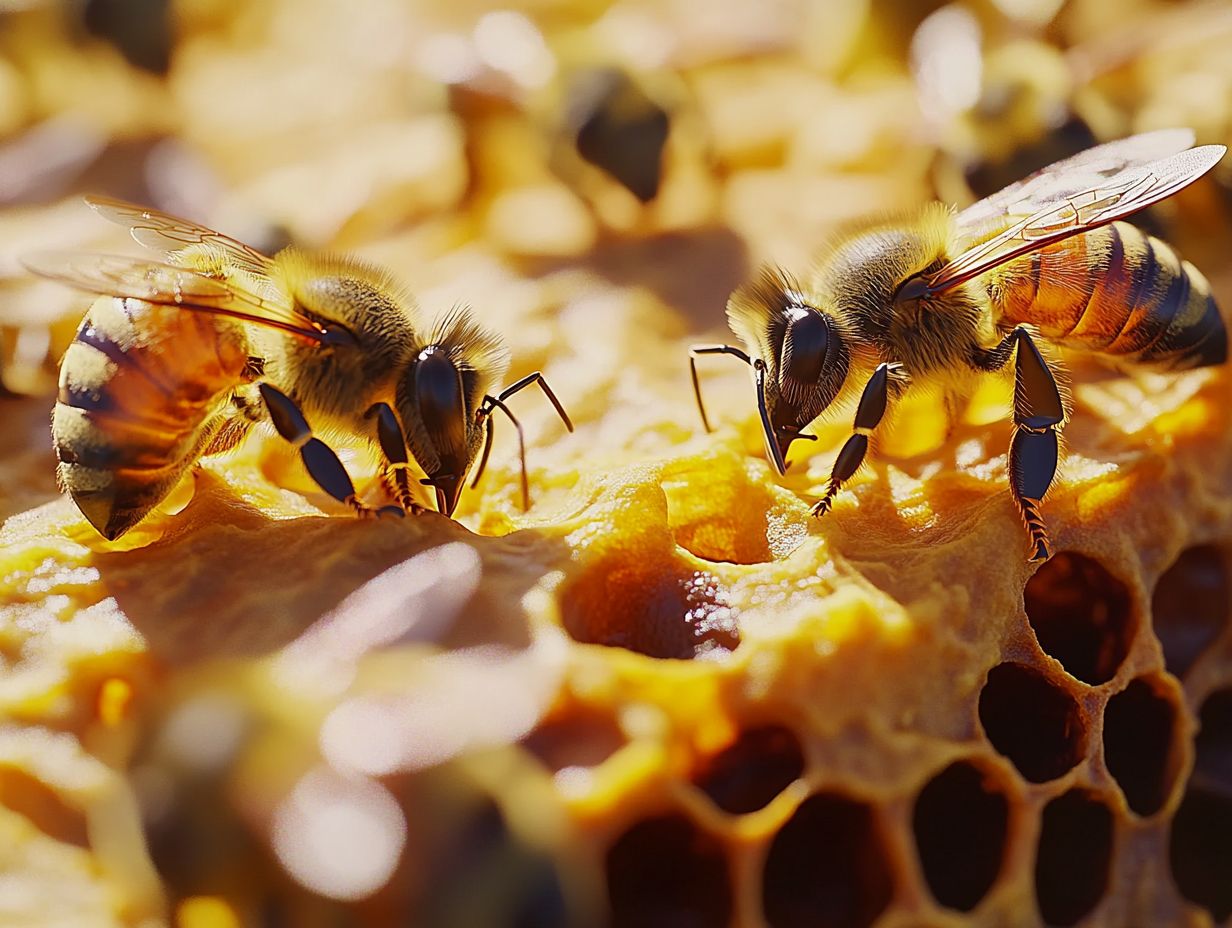
Bees engage in touch communication as a crucial element of their social interactions, enabling the seamless exchange of information and coordination of hive activities among worker bees. This tactile communication unfolds through physical contact think grooming and gentle nudging allowing them to convey vital messages about the hive’s status and collaborate on essential tasks such as nectar processing, hive defense, and brood care.
By embracing touch communication, bees not only strengthen their social bonds but also enhance the effectiveness of their collective efforts, showcasing the significance of physical interactions within the hive.
For instance, when a worker bee returns with nectar, she performs a series of touch-based behaviors to inform her fellow bees of her discoveries, including a delightful dance of antennation where they tap their antennae against one another. This communication method reveals not only where the food is but also its quality and quantity.
Grooming may appear straightforward, but it plays a vital role in fortifying relationships among hive mates and ensuring the colony’s health by removing pathogens. These tactile interactions are not standalone; they work in harmony with other forms of communication, such as pheromonal signals, to create a robust network that underpins the hive’s organization and adaptability.
What Role Do Vibrations Play in Bee Communication?
Vibrations play a vital role in how bees communicate. They act as an essential way to share information about hive activities and bolster collaborative efforts. Worker bees harness vibrational signals generated through the fluttering of their wings or movement of their bodies to relay crucial messages about the hive s status.
These signals alert fellow bees to changes in their environment or potential threats. In moments of hive defense, this form of communication truly shines. It enables swift mobilization and a rapid response to dangers, fortifying the colony s resilience and efficiency.
The subtleties of these vibrational cues can convey a range of social information, such as a queen s readiness to mate or the location of a newly discovered food source. The bees perceive these vibrations through their exquisitely sensitive bodies, equipped with specialized receptors that allow them to detect even the slightest shifts in frequency and amplitude. Discovering how bees use these vibrational signals is fascinating and essential!
This vibrational communication operates alongside pheromonal signals, which are scents released by bees to convey messages. Together, they weave a complex tapestry of interactions that keeps the colony informed about their surroundings. For a deeper insight into this fascinating topic, consider exploring understanding honeybee behavior in hives. Ultimately, this communication not only sharpens their immediate responses to survive but also cultivates an inherent harmony within the hive, ensuring that every member remains in sync.
Do Bees Use Sound to Communicate?
Bees indeed employ sound as part of their intricate communication repertoire, although it may not be as pronounced as their use of pheromonal and tactile signals. The sounds they produce like buzzing carry essential information about hive conditions and social interactions among worker bees. These auditory signals are vital supplements to their communication methods, enabling them to coordinate activities and respond adeptly to changes in their environment.
For example, the intensity and frequency of a bee’s buzzing can reveal the urgency of a situation. It can signal a potential threat to the hive or indicate the need for additional foragers to gather nectar. Different species may produce distinct vibrations to indicate specific tasks or distress signals, weaving a rich tapestry of sound that extends far beyond mere buzzing.
By integrating these auditory cues with their renowned scent-based messaging, bees bolster their overall communicative efficiency. This ensures that crucial information circulates swiftly within the colony. This synergy strengthens their communal bonds and resilience, enhancing their survival strategies in an ever-changing world.
The Importance of Understanding Bee Communication
Grasping the nuances of bee communication is crucial for both beekeepers and researchers. It offers invaluable insights into the intricate dynamics of hive behavior and the overall vitality of bee colonies.
By understanding the diverse modes of communication pheromonal, tactile, and vibrational signals you can effectively manage your hives. This creates ideal conditions for honey production and ensures the sustainability of your colonies. This knowledge is particularly valuable when dealing with European honeybee populations.
This knowledge also deepens your appreciation for the complex social interactions of honey bees. It fosters a stronger connection to these essential pollinators and their role in our ecosystem. Even aspects like the development stages of bee larvae are critical to understanding the hive’s social structure.
To learn more about bee communication and behavior and appreciate its significance, explore further the fascinating world of bees and their vital contribution to our ecosystem!
How Can Understanding Bee Communication Help Beekeepers?
Understanding bee communication can profoundly enhance your hive management skills, enabling you to accurately interpret the signals and behaviors of your bees. By recognizing the importance of chemical signals, for example, you can ascertain the health and productivity of the queen bee, ensuring a stable environment for your hive.
Understanding the dance language allows you to gauge nectar availability, enabling you to make informed decisions about foraging patterns and resource allocation ultimately boosting your honey production.
By keenly observing these communication cues, you ll spot early stress signs in the colony, which might manifest as reduced activity or shifts in the bees’ pheromone signatures. If you notice signs of aggression or disorganization, it may indicate overcrowding or insufficient resources. Taking quick action on signs of aggression can prevent bigger issues, prompting you to consider hive expansion or supplemental feeding.
Using these insights in your management practices not only promotes healthier colonies but also contributes to the sustainability of your operations, leading to increased honey yields and fostering a more resilient ecosystem.
What Can We Learn from Bee Communication in Terms of Human Communication?
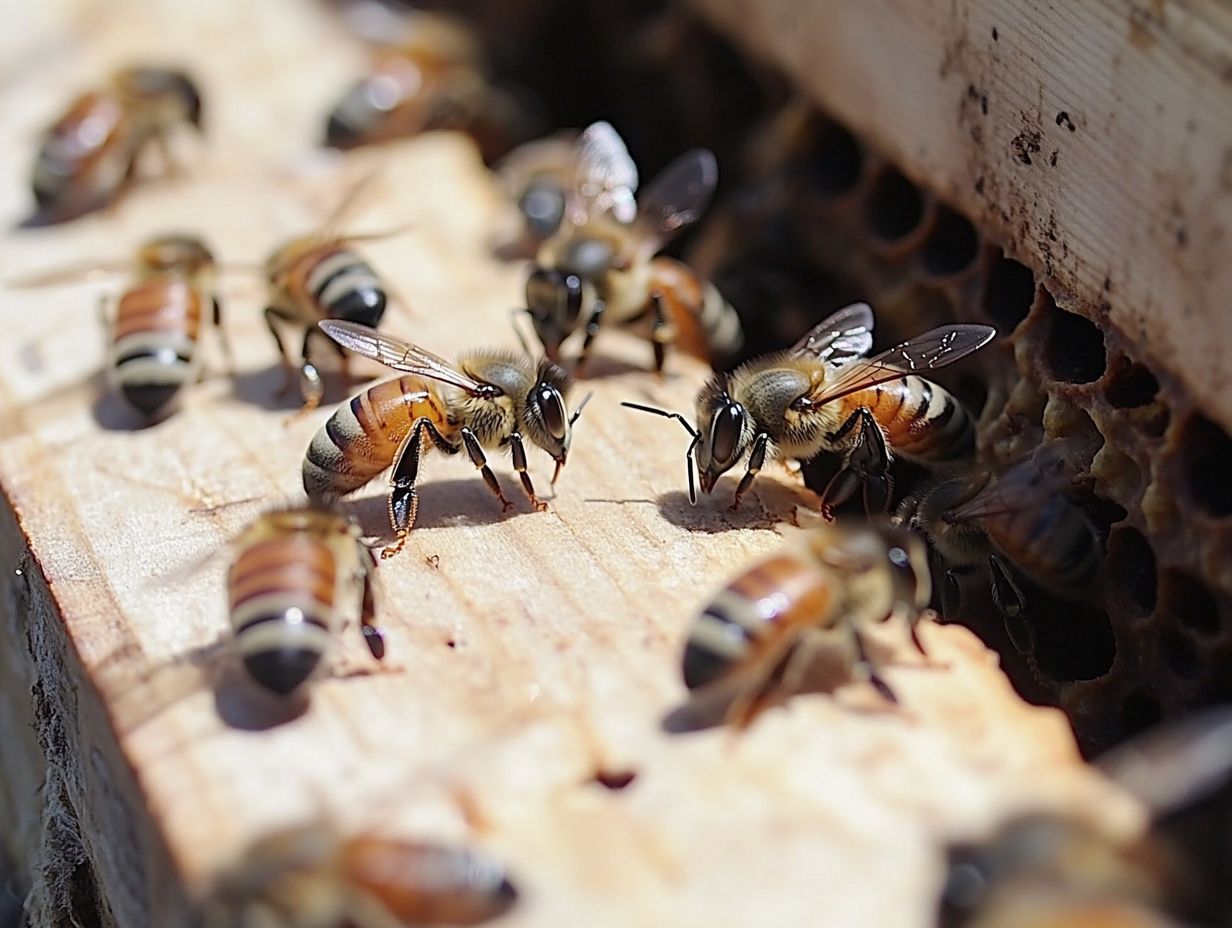
The study of bee communication provides you with invaluable insights into human communication, particularly regarding the principles of collective intelligence and social behavior. By exploring how bees use various forms of communication like chemical signals and complex movements you can draw parallels to your interactions and recognize the significance of effective messaging in group dynamics.
Grasping these natural communication strategies not only deepens your understanding of social behavior in bees but also enhances your approach to fostering collaboration and cooperation in your own communities.
Consider this: just as honeybees, such as Apis mellifera (the common honeybee), convey the location of resources through their elaborate movements, you can learn to articulate your ideas clearly and set specific objectives to boost teamwork. The synergy present in bee colonies underscores the importance of individuals contributing their strengths while staying aligned toward a shared goal. Notable researchers like Karl von Frisch and Dr. J rgen Tautz have studied these behaviors extensively.
In organizational settings, embracing these principles can lead to greater trust and social cohesion among team members, creating an environment where diverse perspectives are genuinely valued. By emphasizing clarity and inclusiveness in your communications, you can cultivate a more harmonious and productive atmosphere, ultimately driving collective success, much like a perfectly functioning hive. Adrian Wenner’s studies at Cornell University have shown how these principles apply in both bee and human communities.
Frequently Asked Questions
What is bee communication (Robobee)?
Bee communication is the exchange of information and signals among bees in a hive. This is essential for their survival and functioning as a colony.
How do bees communicate?
Bees communicate through various means, including pheromones, body movements, and sounds. They use these methods to convey important information such as food sources, danger, and the location of the hive.
What is the purpose of bee communication in hives?
Bee communication serves several purposes in hives, including coordinating foraging activities, regulating the temperature of the hive, and organizing the development of young bees.
Can bees, including the European honeybee, communicate with other species?
Yes, bees can communicate with other species, including plants, through the use of pheromones and dances. This helps them to locate sources of nectar and pollen.
What is the role of pheromones in bee communication (Apis mellifera)?
Pheromones are chemical substances secreted by bees to convey information to other members of the colony. They can signal various messages, such as alarm, food availability, and reproductive status.
How do bees, as studied by Karl von Frisch, use dances to communicate?
Bees perform a special dance called the waggle dance. This dance helps them share where to find food and how far away it is.
Karl von Frisch’s research uncovered this amazing behavior. Bees also use different dances to indicate how good the food is and to suggest new places for their hive.

